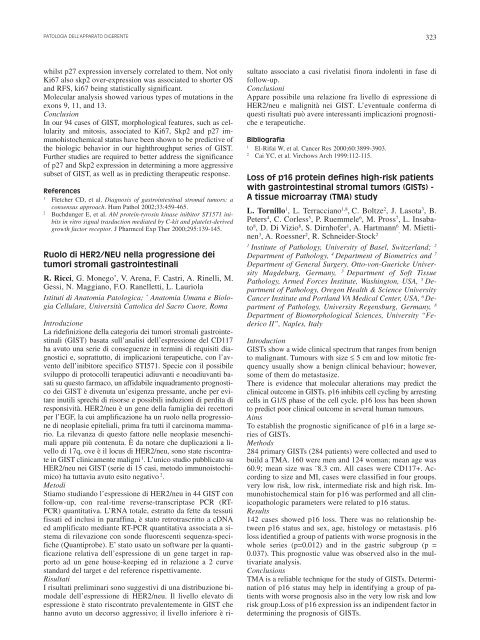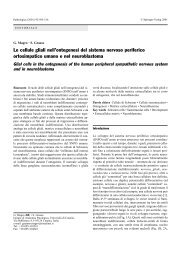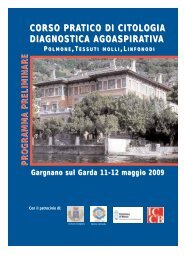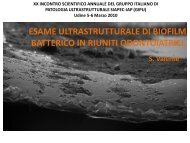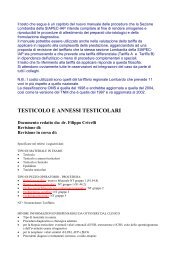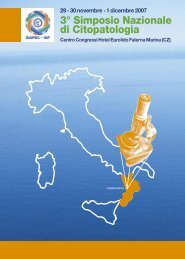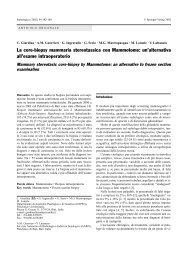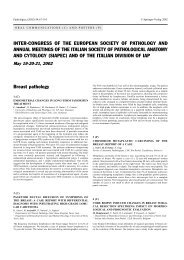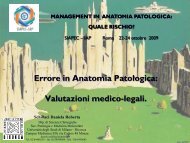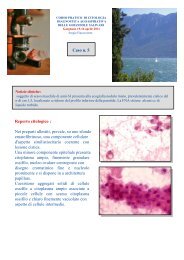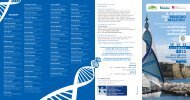Create successful ePaper yourself
Turn your PDF publications into a flip-book with our unique Google optimized e-Paper software.
PATOLOGIA DELL’APPARATO DIGERENTE323whilst p27 expression inversely correlated to them. Not onlyKi67 also skp2 over-expression was associated to shorter OSand RFS, ki67 being statistically significant.Molecular analysis showed various types of mutations in theexons 9, 11, and 13.ConclusionIn our 94 cases of GIST, morphological features, such as cellularityand mitosis, associated to Ki67, Skp2 and p27 immunohistochemicalstatus have been shown to be predictive ofthe biologic behavior in our highthroughput series of GIST.Further studies are required to better address the significanceof p27 and Skp2 expression in determining a more aggressivesubset of GIST, as well as in predicting therapeutic response.References1Fletcher CD, et al. Diagnosis of gastrointestinal stromal tumors: aconsensus approach. Hum Pathol 2002;33:459-465.2Buchdunger E, et al. Abl protein-tyrosin kinase inibitor ST1571 inibitsin vitro signal trasduction mediated by C-kit and platelet-derivedgrowth factor receptor. J Pharmcol Exp Ther 2000;<strong>295</strong>:139-145.Ruolo di HER2/NEU nella progressione deitumori stromali gastrointestinaliR. Ricci, G. Monego * , V. Arena, F. Castri, A. Rinelli, M.Gessi, N. Maggiano, F.O. Ranelletti, L. LauriolaIstituti di Anatomia Patologica; * Anatomia Umana e BiologiaCellulare, Università Cattolica del Sacro Cuore, RomaIntroduzioneLa ridefinizione della categoria dei tumori stromali gastrointestinali(GIST) basata sull’analisi dell’espressione del CD117ha avuto una serie di conseguenze in termini di requisiti diagnosticie, soprattutto, di implicazioni terapeutiche, con l’avventodell’inibitore specifico STI571. Specie con il possibilesviluppo di protocolli terapeutici adiuvanti e neoadiuvanti basatisu questo farmaco, un affidabile inquadramento prognosticodei GIST è divenuta un’esigenza pressante, anche per evitareinutili sprechi di risorse e possibili induzioni di perdita diresponsività. HER2/neu è un gene della famiglia dei recettoriper l’EGF, la cui amplificazione ha un ruolo nella progressionedi neoplasie epiteliali, prima fra tutti il carcinoma mammario.La rilevanza di questo fattore nelle neoplasie mesenchimaliappare più contenuta. È da notare che duplicazioni a livellodi 17q, ove è il locus di HER2/neu, sono state riscontratein GIST clinicamente maligni 1 . L’unico studio pubblicato suHER2/neu nei GIST (serie di 15 casi, metodo immunoistochimico)ha tuttavia avuto esito negativo 2 .MetodiStiamo studiando l’espressione di HER2/neu in 44 GIST confollow-up, con real-time reverse-transcriptase PCR (RT-PCR) quantitativa. L’RNA totale, estratto da fette da tessutifissati ed inclusi in paraffina, è stato retrotrascritto a cDNAed amplificato mediante RT-PCR quantitativa associata a sistemadi rilevazione con sonde fluorescenti sequenza-specifiche(Quantiprobe). E’ stato usato un software per la quantificazionerelativa dell’espressione di un gene target in rapportoad un gene house-keeping ed in relazione a 2 curvestandard del target e del reference rispettivamente.RisultatiI risultati preliminari sono suggestivi di una distribuzione bimodaledell’espressione di HER2/neu. Il livello elevato diespressione è stato riscontrato prevalentemente in GIST chehanno avuto un decorso aggressivo; il livello inferiore è risultatoassociato a casi rivelatisi finora indolenti in fase difollow-up.ConclusioniAppare possibile una relazione fra livello di espressione diHER2/neu e malignità nei GIST. L’eventuale conferma diquesti risultati può avere interessanti implicazioni prognostichee terapeutiche.Bibliografia1El-Rifai W, et al. Cancer Res 2000;60:3899-3903.2Cai YC, et al. Virchows Arch 1999:112-115.Loss of p16 protein defines high-risk patientswith gastrointestinal stromal tumors (GISTs) -A tissue microarray (TMA) studyL. Tornillo 1 , L. Terracciano 1,8 , C. Boltze 2 , J. Lasota 3 , B.Peters 4 , C. Corless 5 , P. Ruemmele 6 , M. Pross 7 , L. Insabato8 , D. Di Vizio 8 , S. Dirnhofer 1 , A. Hartmann 6 M. Miettinen3 , A. Roessner 2 , R. Schneider-Stock 2 ,1Institute of Pathology, University of Basel, Switzerland; 2Department of Pathology, 4 Department of Biometrics and 7Department of General Surgery. Otto-von-Guericke UniversityMagdeburg, Germany, 3 Department of Soft TissuePathology, Armed Forces Institute, Washington, USA, 5 Departmentof Pathology, Oregon Health & Science UniversityCancer Institute and Portland VA Medical Center, USA, 6 Departmentof Pathology, University Regensburg, Germany, 8Department of Biomorphological Sciences, University “FedericoII”, Naples, ItalyIntroductionGISTs show a wide clinical spectrum that ranges from benignto malignant. Tumours with size ≤ 5 cm and low mitotic frequencyusually show a benign clinical behaviour; however,some of them do metastasize.There is evidence that molecular alterations may predict theclinical outcome in GISTs. p16 inhibits cell cycling by arrestingcells in G1/S phase of the cell cycle. p16 loss has been shownto predict poor clinical outcome in several human tumours.AimsTo establish the prognostic significance of p16 in a large seriesof GISTs.Methods284 primary GISTs (284 patients) were collected and used tobuild a TMA. 160 were men and 124 woman; mean age was60.9; mean size was ¨8.3 cm. All cases were CD117+. Accordingto size and MI, cases were classified in four groups.very low risk, low risk, intermediate risk and high risk. Immunohistochemicalstain for p16 was performed and all clinicopathologicparameters were related to p16 status.Results142 cases showed p16 loss. There was no relationship betweenp16 status and sex, age, histology or metastasis. p16loss identified a group of patients with worse prognosis in thewhole series (p=0.012) and in the gastric subgroup (p =0.037). This prognostic value was observed also in the multivariateanalysis.ConclusionsTMA is a reliable technique for the study of GISTs. Determinationof p16 status may help in identifying a group of patientswith worse prognosis also in the very low risk and lowrisk group.Loss of p16 expression iss an indipendent factor indetermining the prognosis of GISTs.


